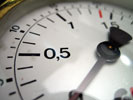

Why would anybody want to measure pressure in a remote location where typically no power is available? What would such a measurement be used for (realtime applications or data-logging)? What would be the requirements of a pressure sensor to be used in such an application? These are some of the application-related questions that come to mind.
Introduction
Current loop (4-20 mA) and fieldbus type measuring instrumentation consumes too much power to be used in battery driven applications. For that matter, even the use of a built-in microprocessor in the pressure device for scaling and calibration purposes might cause the instrument to consume too much power.
In many instances, like data-logging, the data will be stored at a given dead band and interval in memory until collected for analysis. Some applications might require action on the measurement in which case the measurement will be passed on to a second, or integrated, battery-driven instrument that can act on the measurement – like an RF transmitter or cellular device.
Requirements
Let us look at the typical requirements for this measurement to make it useful in such an application:
* The instrument must be driven from a battery (typically between 8 and 12 V), and the output must be a high impedance voltage. Usually the load current on the output must be less than 1 mA at 5 V, which gives a power consumption of less than 5 mW. Most commercial transducers will not come close to that value.
* If the output of the sensor is in the mV range it makes field measurement for calibration more difficult.
* Typical battery-operated flowmeters can work for five years from the same battery. For a pressure measurement device to operate for a similar period it would need a 50 Ah battery for the specified requirements.
* Ingress protection requirements determine whether the sensor has to be housed in an additional enclosure or whether it can be, for instance, submerged.
Technology
The cost of pressure transducers varies a lot according to the amount of stainless steel used, the sophistication of the electronic circuitry, the ingress protection requirements, temperature compensation, etc. The manufacturing technology used will also influence the cost, not to speak of additional requirements for a battery driven device. Bonded foil strain gauge (BGSG) transducers have been around for some 60 years, and is a well proven technology. The downside to a BFSG sensor is that it is labour intensive to manufacture due to component matching on the strain gauges. The advantage is that it is more or less a mechanical device, and as such it is easy to design-in over pressure stops that can prevent the instrument from being damaged in the event of a pressure spike. The device electronics is often discrete components, which make it easily adaptable to different output requirements, as in this case for a battery-driven low power device with less than 1% accuracy. These devices can also be used at extreme temperatures from -40 to +120°C.
Typical application
Typical applications can include tyre pressure monitoring, portable blood pressure measurement and water-line pressure monitoring. Each has its own unique set of requirements.
In the water industry (commercial and residential distribution) a device commonly used is a flowmeter. Traditionally these flowmeters are mechanical such as those located at most residential premises and in many cases in the main distribution lines between utilities and reservoirs. Newer types of flowmetering used are battery-driven magnetic and ultrasonic flowmeters. An important requirement for these meters is that they have to be certified for custody transfer (billing purposes). Most open channel flowmetering uses a level measurement and some like at a weir will use a pressure instrument for flow measurement.
Just as in the electrical world where current and voltage together are used to calculate power, measuring both flow and pressure gives a measure of the power required to pump the water. Simplistically stated for electricity the apparent power is S = V*I where V is the voltage and I the current, the power required to pump water is P = p*V where p is the pressure and V is the volumetric flow rate.
In the case of a furnace, measuring only the current and not the voltage would not give a clear idea of the power consumption. In a pumped water application, not having the pressure would be like not having the voltage, and trying to answer the question: why is no water flowing?
Important operational requirements for the water industry like water balancing, leak detection, disaster aversion, demand management, pump station scheduling etc, are all influenced by measurements that have to be taken at locations, where mostly no power supply exists. In South Africa problems like distances between pipe lines, theft of cables and solar panels has forced us to apply old technologies in new ways to overcome these challenges.
At SCE we have been involved in the design of such applications for major water utilities in South Africa, and we have proven technologies for many applications.
For more information contact Jaco Hoogenboezem, Supervisory & Control Expertise SA, +27 (0)83 282 5706, [email protected], www.sce.co.za
© Technews Publishing (Pty) Ltd | All Rights Reserved